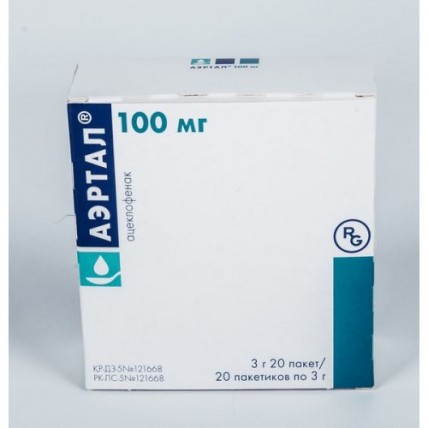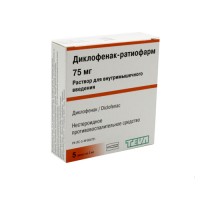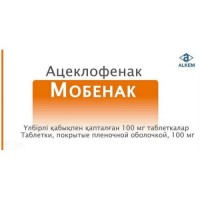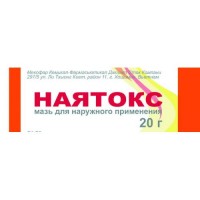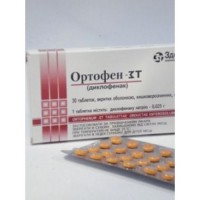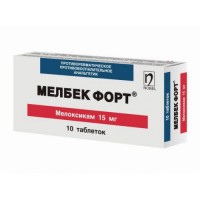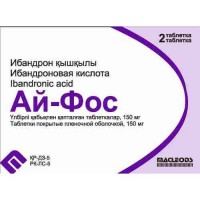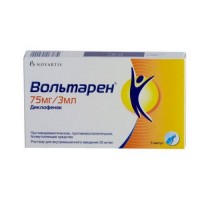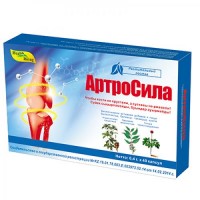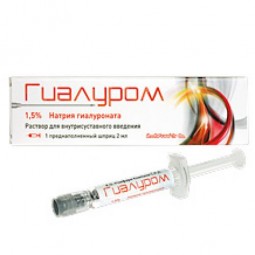Aertal® 20s 100 mg powder for oral suspension
- $21.30
Sku:
b3439c8f2257
Ingredient:
Aceclophenacum
The instruction for medical use
of Aertal® medicine
the Trade name
of Aertal®
the International unlicensed
name Atseklofenak Lekarstvennaya a form
Powder for preparation of suspension for intake, 100 mg
Structure
1 bag of drug contains
active agent: atseklofenak 100 mg,
excipients: sorbitol, sodium saccharinate, aspartame, silicon dioxide colloidal, gipromelloza, titan dioxide (E 171), fragrance milk, fragrance caramel, fragrance cream.
Description
Powder of color, white or white with cream shade.
Pharmacotherapeutic group
Anti-inflammatory and antirheumatic drugs. Non-steroidal anti-inflammatory drugs. Acetic acid derivatives. Atseklofenak.
The ATX M01AB16 code
the Pharmacological
Pharmacokinetics Absorption Later properties of intake atseklofenak is quickly absorbed, its bioavailability is nearly 100%. The maximum concentration in blood plasma is reached approximately in 1.25 - 3 hours after administration of drug. Meal slows down absorption speed, however, does not influence extent of absorption.
Distribution
Atseklofenak has high affinity to proteins (& gt, 99.7%). Atseklofenak gets into synovial fluid where its concentration reaches 60% of concentration in blood plasma. The volume of distribution is nearly 30 liters.
Removal
Average elimination half-life makes 4 - 4.3 hours. The clearance is about 5 l/h. About two thirds of the entered dose of drug are removed by kidneys, generally in the form of conjugated a hydroxyl metabolites. Only 1% of the single dose accepted inside is removed in an invariable look.
Perhaps, atseklofenak it is metabolized by CYP2C9 isoenzyme. The main metabolite is 4-ON-atseklofenak which role in clinical activity of drug, apparently, is insignificant. Diclofenac and 4-IT-diclofenac were distinguished from a large number of metabolites.
Characteristic in different groups of patients
At elderly patients of changes of pharmacokinetics of an atseklofenak was not revealed.
At patients with reduced function of a liver after single dose of an atseklofenak the delay of clearance rate of drug was revealed. In a research of repeated use of an atseklofenak in which the dose of 100 mg of drug of 1 times a day was applied distinctions of pharmacokinetic parameters at patients with poorly and moderate cirrhosis and at the patients who do not have this disease were not revealed.
At patients with poorly or moderate renal failure of clinically significant differences of pharmacokinetic parameters after single use of drug it was not revealed.
The pharmacodynamics
Atseklofenak represents the nonsteroid connection possessing the anti-inflammatory, anesthetizing and febrifugal action. The mechanism of its action is based on inhibition of synthesis of prostaglandins - key enzyme of exchange of arachidonic acid, blocks secretion of prostaglandins, suppresses exudative and proliferative phases of inflammation. Restores microcirculation and reduces painful sensitivity in the inflammation center.
Atseklofenak stimulates synthesis of an extracellular matrix of articulate cartilages (hondroprotektorny action), slows down adhesion and accumulation of neutrophils in the place of inflammation at an early stage and, thus, blocks inflammatory action of neutrophils. In rheumatic diseases the anti-inflammatory and analgeziruyushchy action of an atseklofenak promotes considerable reduction of severity of pain, morning constraint, a swelling of joints that improves a functional condition of the patient.
Atseklofenak treats non-selective non-steroidal anti-inflammatory drugs (NPVP) with primary suppression of activity of TsOG-2 and to a lesser extent influences TsOG-1 participating in synthesis of the prostaglandins which are protecting a mucous membrane of a GIT and taking part in regulation of a blood-groove in kidneys. Thanks to this fact, Aertal has a high profile of safety concerning gastrointestinal side effects.
Indications
- symptomatic treatment of a painful symptom and inflammation in an osteoarthritis, a pseudorheumatism and an ankylosing spondylarthritis and also other diseases of the musculoskeletal system which are followed by pain (for example, a humeroscapular periarthritis and other extraarticular forms of rheumatism)
- the anesthetizing action at various states which are followed by a painful symptom (including lumbar or a toothache and primary dysmenorrhea)
the Route of administration and doses
the Undesirable phenomena can be minimized at use of a minimal effective dose and reduction of duration of treatment to minimum necessary for achievement of control of symptoms of a disease.
Contents of bags should be dissolved in 40-60 ml of water and to accept immediately. The concomitant use of food slows down the speed of absorption of active ingredient, however does not reduce extent of absorption from digestive tract.
Adults
the Recommended dose makes 1 bag 2 times a day (one morning and one evening).
Children
Safety and efficiency of drug for treatment of children and teenagers is not established.
Patients of advanced age
Usually the dose decline is not required, however it is necessary to consider precautionary measures.
A liver failure
At treatment of patients with poorly or moderate abnormal liver function it is necessary to apply lower doses of an atseklofenak. The recommended initial dose makes 100 mg a day.
A renal failure
of the Proof of need of change of a dose of an atseklofenak at treatment of patients with a mild renal failure are absent, however it is recommended to be careful.
Side effects
Gastrointestinal: by-effects from digestive tract are most often observed. At intake of non-steroidal anti-inflammatory drugs (NPVP) the round ulcer, a perforation of the ulcer or gastrointestinal bleeding sometimes leading to death, especially at patients of advanced age can develop. There are messages about development of nausea, vomiting, diarrhea, a meteorism, a constipation, dyspepsia, an abdominal pain, a melena, a hematemesis, a stomacace, exacerbation of colitis or Crohn's disease after introduction of NPVP. Also, with a smaller frequency, gastritis was observed.
Against the background of treatment of NPVP the hypostasis, arterial hypertension and heart failure were observed.
Results of clinical trials and epidemiological data give the grounds to assume that some NPVP (especially at long-term treatment by high doses) can increase risk of arterial trombotichesky complications (for example, a myocardial infarction or a stroke).
Frequent (≥1/100 to & lt, 1/10)
- dizziness
- dyspepsia, an abdominal pain, nausea, diarrhea
- increase in activity of enzymes of a liver
Infrequent (≥1/1000 to & lt, 1/100)
- a meteorism, gastritis, a constipation, vomiting, a stomacace
- an itching, rash, dermatitis, urticaria
- increase in concentration of urea and creatinine of blood serum
Rare (≥1/10000 to & lt, 1/1000)
- anemia
- anaphylactic reactions (including shock), hypersensitivity
- a visual disturbance
- heart failure
- arterial hypertension, deterioration in arterial hypertension
- dispnoe
- a melena, formation of stomach ulcers and intestines, hemorrhagic diarrhea, gastrointestinal bleeding
- a Quincke's edema
Very rare (& lt, 1/10000)
- oppression of function of marrow, a granulocytopenia, thrombocytopenia, a neutropenia, hemolytic anemia
- a hyperpotassemia
- a depression, unusual dreams, insomnia, paresthesia, a tremor, drowsiness, a headache
- a dysgeusia (food faddism)
- a ring in ears
- heartbeat, hyperaemia, inflows, a vasculitis
- a bronchospasm
- stomatitis
- vomiting blood, an intestines perforation, exacerbation of Crohn's disease and ulcer colitis, pancreatitis, a liver disease (including hepatitis)
- increase in activity of alkaline phosphatase
- a purpura, eczema, heavy skin and mucous reactions (including Stephens-Johnson's syndrome and a toxic epidermal necrolysis)
- the nephrotic syndrome, interstitial nephrite, a renal failure
- swelled, weakness, muscular spasms
- increase in body weight
In exclusively exceptional cases the chicken pox can provoke serious infectious complications from skin and soft tissues.
Contraindications
- hypersensitivity to active ingredient or any of excipients
- patients who have connections possessing similar action (for example, acetylsalicylic acid or other NPVP), caused asthma attacks, a bronchospasm, acute rhinitis or a small tortoiseshell or hypersensitivity to these drugs
- patients with existence in the anamnesis of gastrointestinal bleeding or a perforation of the ulcer, connected with treatment by NPVP, an active, expected or recurrent round ulcer or ulcer/bleeding of a duodenum in the anamnesis (two or more separate episodes of the confirmed stomach ulcer or intestines or bleeding)
- patients with active bleeding or disturbance of blood clotting (hemorrhagic diathesis or disturbance of fibrillation)
- heart failure (functional class II-IV on NYHA), coronary heart disease, diseases of peripheral arteries or cerebrovascular diseases.
- heavy abnormal liver functions or kidneys
- pregnancy and the period of a lactation
- children's and teenage age up to 18 years
Medicinal interactions
Researches of medicinal interactions were not conducted, except for interaction researches with warfarin.
Atseklofenak is metabolized in the system of P450 2C9 cytochrome and, according to data of the researches in vitro, atseklofenak can inhibit this enzyme. Therefore the risk of pharmacokinetic interaction with Phenytoinum, Cimetidinum, tolbutamide, phenylbutazone, Amiodaronum, Miconazolum and sulfafenazoly is possible. As well as in case of other drugs of the NPVP group, there is also a risk of pharmacokinetic interactions with other drugs, actively removed kidneys, such as methotrexate and lithium. Atseklofenak almost completely contacts proteins of blood plasma, therefore, there is an interaction probability with other drugs having high affinity to proteins of blood plasma as substitution which should be considered.
As researches of pharmacokinetic interactions are not enough, information given below is based on the data obtained for other NPVP:
It is necessary to avoid the following combinations
of drugs NPVP inhibit canalicular secretion of a methotrexate, besides, the insignificant medicinal interaction leading to decrease in clearance of a methotrexate therefore during treatment by high doses of a methotrexate it is always necessary to avoid purpose of NPVP can take place.
Lithium and digoxin: some NPVP inhibit renal clearance of lithium and digoxin that leads to increase in concentration of these drugs in blood serum. It is necessary to avoid this combination of drugs, except for cases when frequent monitoring of concentration of lithium and digoxin is possible.
Anticoagulants: NPVP inhibit aggregation of thrombocytes and injure a mucous membrane of digestive tract that can lead to increase in activity of anticoagulants and increase risk of gastrointestinal bleeding at the patients accepting anticoagulants. It is necessary to avoid purpose of a combination of an atseklofenak and anticoagulants of coumarinic group for intake, a tiklopidin, thrombolytic drugs and heparin, except for cases when careful monitoring is carried out.
Antiagregantny drugs and selective serotonin reuptake inhibitors in a combination with NPVP can increase risk of gastrointestinal bleeding.
The combinations of drugs given below can demand dose adjustment and respect for care
the Methotrexate: It is also necessary to consider possible interactions between NPVP and a methotrexate at treatment by low doses of a methotrexate, especially at patients with a renal failure. In cases when it is necessary to perform the combined treatment, it is necessary to control function of kidneys. It is necessary to be careful in cases when both NPVP, and a methotrexate are entered in common within 24 hours as concentration of a methotrexate can increase that will lead to increase in its toxicity.
Cyclosporine, takrolimus: It is considered that simultaneous use of NPVP and cyclosporine or a takrolimus increases risk of renal toxicity because of decrease in synthesis of prostacyclin kidneys. Therefore it is very important to control carefully function of kidneys during the combined treatment.
Other NPVP: Simultaneous use of acetylsalicylic acid and other non-steroidal anti-inflammatory drugs can increase the frequency of the undesirable phenomena therefore it is necessary to be careful.
Diuretics: Atseklofenak, as well as other NPVP, can inhibit activity of diuretics, reduce diuretic effect of furosemide, a bumetanid and hypotensive effect of tiazid. Simultaneous treatment by kaliysberegayushchy diuretics is connected with increase in content of potassium, therefore, it can be necessary to control potassium content in blood serum.
It was shown what atseklofenak does not influence control of arterial blood pressure at simultaneous introduction with bendrofluazidy in spite of the fact that medicinal interactions with other diuretics cannot be excluded.
Hypotensive drugs: NPVP can also reduce efficiency of certain hypotensive drugs. APF inhibitors or antagonists of receptors of angiotensin II in a combination with NPVP can lead to a renal failure. At some patients with reduced function of kidneys, for example, at patients of advanced age or patients with dehydration, the risk of an acute renal failure which is usually reversible can take place. Therefore, it is necessary to be careful at the combined use of these drugs with NPVP, especially at treatment of elderly patients or patients with dehydration. Patients have to be hydrated sufficiently, besides, it is recommended to consider need of monitoring of function of kidneys after the beginning of the combined treatment and also periodically subsequently.
It was shown what atseklofenak does not influence control of arterial blood pressure at simultaneous introduction with bendrofluazidy in spite of the fact that interactions with other diuretics cannot be excluded.
Hypoglycemic drugs: In clinical trials it was shown that diclofenac can be applied along with hypoglycemic drugs to intake, without affecting their clinical performance. However there are separate messages about hypoglycemic and hyper glycemic effect of this drug. Therefore, concerning an atseklofenak, it is necessary to consider a possibility of dose adjustment of drugs which can cause a hypoglycemia.
Zidovudine: At simultaneous use of NPVP and zidovudine the risk of hematologic toxicity increases. The HIV-positive patients having hemophilia, and receiving the accompanying treatment by a zidovudine and an ibuprofen have data on increase in risk of a hemarthrosis and formation of hematomas.
Special instructions
It is necessary to avoid use of the drug Aertal® along with other NPVP, including selection inhibitors of cyclooxygenase-2.
The undesirable phenomena can be minimized if as much as possible to reduce treatment duration to minimum necessary for achievement of control of symptoms of a disease.
Influence on digestive tract
there Are messages about gastrointestinal bleeding, forming of stomach ulcer or intestines or a perforation of the ulcer which can lead to death, at reception of any NPVP, against the background of treatment, followed or not followed by disturbing symptoms, irrespective of existence in the anamnesis of serious gastrointestinal complications at any time.
The risk of gastrointestinal bleeding, ulceration or a perforation of the ulcer is higher at treatment by high doses of NPVP at patients with ulcer of stomach or intestines in the anamnesis, especially if it is complicated by bleeding or a perforation and also at elderly patients. Treatment of these patients should be begun with the smallest effective dose. Also, at treatment of these groups of patients and patients who need simultaneous use of acetylsalicylic acid in small doses or other drugs which can increase risk of development of gastrointestinal complications it is necessary to consider the possibility of combination therapy with protective drugs (for example, mizoprostoly or inhibitors of a proton pomp).
Patients with gastrointestinal toxicity in the anamnesis, first of all elderly, have to report about any unusual symptoms in a stomach (especially about gastrointestinal bleeding), paying attention maximum to symptoms at early stages of treatment. It is necessary to be careful at treatment of the patients receiving the accompanying medicines which can increase risk of ulceration or bleeding, such as corticosteroids of systemic action, anticoagulants, for example, warfarin, selective serotonin reuptake inhibitors or antiagregantny drugs, such as acetylsalicylic acid.
In case of appearance of gastrointestinal bleeding or ulceration in the patients accepting Aertal®, treatment should be cancelled.
Atseklofenak it is necessary to appoint with care and under careful medical observation to patients with the diseases which are listed below as there can be a deterioration in their course:
- the symptoms indicating gastrointestinal diseases including upper and lower departments of digestive tract
- an ulcer, bleeding or a perforation of the ulcer of a stomach or intestines in the anamnesis
- ulcer colitis
- Crohn's disease
- hematologic diseases, the system lupus erythematosus (SLE), a porphyria and disturbances of a hemopoiesis
Influence on a cardiovascular system and blood supply of a brain
At treatment of patients with arterial hypertension and/or stagnant heart failure from weak to moderate expressiveness it is necessary to make the corresponding observation and to make recommendations as there are messages about development of a delay of liquid and hypostases against the background of treatment of NPVP.
Results of clinical trials and epidemiological data give the grounds to believe that some NPVP (especially in high doses and at long-term treatment) can cause increase in risk of development of arterial trombotichesky complications (for example, a myocardial infarction or a stroke). For an exception of this risk at use of an atseklofenak there are not enough data.
At patients with uncontrollable arterial hypertension, stagnant heart failure (functional class I on NYHA),
with risk factors for a cardiovascular system (for example, arterial hypertension, a lipidemia, diabetes and smoking) it is necessary to observe extra care at use of an atseklofenak.
Also patients should be careful and carry out careful medical observation when assigning an atseklofenak with cerebrovascular bleeding in the anamnesis.
Influence on a liver and kidneys
Treatment of NPVP can cause reduction of synthesis of prostaglandins, dependent on a dose, and provoke a renal failure. It is necessary to take into account importance of prostaglandins for maintenance of a renal blood-groove at patients with dysfunctions of heart or kidneys, dysfunction of a liver, the patients receiving treatment by diuretics or who are restored after band operation and also elderly patients.
It is necessary to be careful at treatment of patients with abnormal liver functions or kidneys and also patients with other diseases contributing to a liquid delay. At these patients the treatment of NPVP can lead to a renal failure and to a liquid delay in an organism. It is also necessary to be careful when prescribing drug to the patients receiving treatment by diuretics or, on the contrary, patients with risk of a hypovolemia. It is necessary to appoint minimum effective dose and to carry out regular control of renal function. Influence of drug on function of kidneys is usually reversible after cancellation of an atseklofenak.
It is necessary to cancel treatment atseklofenaky if deviations of indicators of functional tests of a liver from normal values remain or increase at emergence of the clinical symptoms corresponding to development of a liver failure or in case of other manifestations (for example, eosinophilias, rashes).
Hepatitis can develop without the previous symptoms.
At patients with a hepatic porphyria the use of NPVP can provoke exacerbation of a disease.
The hypersensitivity and skin reactions
As well as in case of use of other NPVP, on early exposure of drug can appear allergic reactions, including anaphylactic/anaphylactoid reactions. Serious skin reactions, including exfoliative dermatitis, Stephens-Johnson's syndrome and a toxic epidermal necrolysis were seldom or never observed, some of them can lead to death. Patients are subject to the highest risk of development of these reactions at the beginning of a course of treatment, in most cases reactions demonstrate in the first month of treatment. At the first symptoms of skin rash, injury of mucous membranes or any other symptoms of hypersensitivity it is necessary to cancel treatment of Aertalom®.
In exclusively exceptional cases the chicken pox can provoke serious infectious complications from skin and soft tissues. At the moment it is impossible to exclude NPVP role in deterioration in a course of these infectious diseases. Therefore, it is recommended to avoid purpose of Aertala® in chicken pox.
Influence on hematologic indicators
Atseklofenak can inhibit aggregation of thrombocytes reversibly.
Disturbances from a respiratory system
need to be careful when prescribing drug the patients having bronchial asthma or with bronchial asthma in the anamnesis as there are messages that NPVP can cause a bronchospasm in such patients.
Patients of advanced age
It is necessary to be careful at treatment of patients of advanced age as in this age group the frequency of the undesirable phenomena connected with treatment NPVP, especially gastrointestinal bleedings and perforations of the ulcer which can lead to death is increased. Besides, patients of advanced age are more subject to a renal, liver or cardiovascular failure.
Long-term treatment
It is necessary to observe carefully all patients receiving long-term treatment by non-steroidal anti-inflammatory drugs regularly making the general blood test, functional tests of a liver and kidneys.
Each bag of the drug Aertal® contains 2.64 g of sorbitol which can cause complaints from digestive tract and diarrhea. Patients with rare hereditary intolerance of fructose cannot appoint this drug.
Аэртал® contains aspartame, a phenylalanine source. Patients with phenylketonuria have to consider that each bag contains 5.61 mg of phenylalanine.
Features of influence of medicine on ability to run the vehicle and potentially dangerous mechanisms
Patients who test weakness, dizziness, a disorientation or other disturbances from the central nervous system during drug treatment should not run vehicles and work with mechanisms.
Overdose
Symptoms: nausea, vomiting, stomach ache, dizziness, drowsiness and headache.
Treatment: antacids as necessary and other types of the supporting and symptomatic treatment of complications, such as arterial hypotension, renal failure, spasms, irritation of digestive tract and respiratory depression.
Treatment of acute poisoning atseklofenaky for intake: consists of the fastest prevention of absorption after introduction of an excess dose of drug by means of gastric lavage and multiple dose of activated carbon. The artificial diuresis, dialysis and hemoperfusion can be inefficient for removal of NPVP because of their high affinity to proteins of blood plasma and active metabolism.
The form of release and packing
On 3 g of drug place in bags from paper / aluminum foil / polyethylene (PENP).
On 20 bags together with the instruction for medical use in the state and Russian languages place in a pack from cardboard.
To Store storage conditions at a temperature not over 30 of 0C.
To store out of children's reach!
Period of storage
4 years.
Not to use after expiry date!
Prescription status
According to the prescription.
The name and the country
of the Pharmasyyutikas Almiral Indastrias manufacturing organization, S.A. Barselon, Spain
the Name and the country of the organization of the packer
Indastrias Pharmasyyutikas
Almiral, S.A. Barselona, Spain
to Develop
of Aertal® medicine
the Trade name
of Aertal®
the International unlicensed
name Atseklofenak Lekarstvennaya a form
Powder for preparation of suspension for intake, 100 mg
Structure
1 bag of drug contains
active agent: atseklofenak 100 mg,
excipients: sorbitol, sodium saccharinate, aspartame, silicon dioxide colloidal, gipromelloza, titan dioxide (E 171), fragrance milk, fragrance caramel, fragrance cream.
Description
Powder of color, white or white with cream shade.
Pharmacotherapeutic group
Anti-inflammatory and antirheumatic drugs. Non-steroidal anti-inflammatory drugs. Acetic acid derivatives. Atseklofenak.
The ATX M01AB16 code
the Pharmacological
Pharmacokinetics Absorption Later properties of intake atseklofenak is quickly absorbed, its bioavailability is nearly 100%. The maximum concentration in blood plasma is reached approximately in 1.25 - 3 hours after administration of drug. Meal slows down absorption speed, however, does not influence extent of absorption.
Distribution
Atseklofenak has high affinity to proteins (& gt, 99.7%). Atseklofenak gets into synovial fluid where its concentration reaches 60% of concentration in blood plasma. The volume of distribution is nearly 30 liters.
Removal
Average elimination half-life makes 4 - 4.3 hours. The clearance is about 5 l/h. About two thirds of the entered dose of drug are removed by kidneys, generally in the form of conjugated a hydroxyl metabolites. Only 1% of the single dose accepted inside is removed in an invariable look.
Perhaps, atseklofenak it is metabolized by CYP2C9 isoenzyme. The main metabolite is 4-ON-atseklofenak which role in clinical activity of drug, apparently, is insignificant. Diclofenac and 4-IT-diclofenac were distinguished from a large number of metabolites.
Characteristic in different groups of patients
At elderly patients of changes of pharmacokinetics of an atseklofenak was not revealed.
At patients with reduced function of a liver after single dose of an atseklofenak the delay of clearance rate of drug was revealed. In a research of repeated use of an atseklofenak in which the dose of 100 mg of drug of 1 times a day was applied distinctions of pharmacokinetic parameters at patients with poorly and moderate cirrhosis and at the patients who do not have this disease were not revealed.
At patients with poorly or moderate renal failure of clinically significant differences of pharmacokinetic parameters after single use of drug it was not revealed.
The pharmacodynamics
Atseklofenak represents the nonsteroid connection possessing the anti-inflammatory, anesthetizing and febrifugal action. The mechanism of its action is based on inhibition of synthesis of prostaglandins - key enzyme of exchange of arachidonic acid, blocks secretion of prostaglandins, suppresses exudative and proliferative phases of inflammation. Restores microcirculation and reduces painful sensitivity in the inflammation center.
Atseklofenak stimulates synthesis of an extracellular matrix of articulate cartilages (hondroprotektorny action), slows down adhesion and accumulation of neutrophils in the place of inflammation at an early stage and, thus, blocks inflammatory action of neutrophils. In rheumatic diseases the anti-inflammatory and analgeziruyushchy action of an atseklofenak promotes considerable reduction of severity of pain, morning constraint, a swelling of joints that improves a functional condition of the patient.
Atseklofenak treats non-selective non-steroidal anti-inflammatory drugs (NPVP) with primary suppression of activity of TsOG-2 and to a lesser extent influences TsOG-1 participating in synthesis of the prostaglandins which are protecting a mucous membrane of a GIT and taking part in regulation of a blood-groove in kidneys. Thanks to this fact, Aertal has a high profile of safety concerning gastrointestinal side effects.
Indications
- symptomatic treatment of a painful symptom and inflammation in an osteoarthritis, a pseudorheumatism and an ankylosing spondylarthritis and also other diseases of the musculoskeletal system which are followed by pain (for example, a humeroscapular periarthritis and other extraarticular forms of rheumatism)
- the anesthetizing action at various states which are followed by a painful symptom (including lumbar or a toothache and primary dysmenorrhea)
the Route of administration and doses
the Undesirable phenomena can be minimized at use of a minimal effective dose and reduction of duration of treatment to minimum necessary for achievement of control of symptoms of a disease.
Contents of bags should be dissolved in 40-60 ml of water and to accept immediately. The concomitant use of food slows down the speed of absorption of active ingredient, however does not reduce extent of absorption from digestive tract.
Adults
the Recommended dose makes 1 bag 2 times a day (one morning and one evening).
Children
Safety and efficiency of drug for treatment of children and teenagers is not established.
Patients of advanced age
Usually the dose decline is not required, however it is necessary to consider precautionary measures.
A liver failure
At treatment of patients with poorly or moderate abnormal liver function it is necessary to apply lower doses of an atseklofenak. The recommended initial dose makes 100 mg a day.
A renal failure
of the Proof of need of change of a dose of an atseklofenak at treatment of patients with a mild renal failure are absent, however it is recommended to be careful.
Side effects
Gastrointestinal: by-effects from digestive tract are most often observed. At intake of non-steroidal anti-inflammatory drugs (NPVP) the round ulcer, a perforation of the ulcer or gastrointestinal bleeding sometimes leading to death, especially at patients of advanced age can develop. There are messages about development of nausea, vomiting, diarrhea, a meteorism, a constipation, dyspepsia, an abdominal pain, a melena, a hematemesis, a stomacace, exacerbation of colitis or Crohn's disease after introduction of NPVP. Also, with a smaller frequency, gastritis was observed.
Against the background of treatment of NPVP the hypostasis, arterial hypertension and heart failure were observed.
Results of clinical trials and epidemiological data give the grounds to assume that some NPVP (especially at long-term treatment by high doses) can increase risk of arterial trombotichesky complications (for example, a myocardial infarction or a stroke).
Frequent (≥1/100 to & lt, 1/10)
- dizziness
- dyspepsia, an abdominal pain, nausea, diarrhea
- increase in activity of enzymes of a liver
Infrequent (≥1/1000 to & lt, 1/100)
- a meteorism, gastritis, a constipation, vomiting, a stomacace
- an itching, rash, dermatitis, urticaria
- increase in concentration of urea and creatinine of blood serum
Rare (≥1/10000 to & lt, 1/1000)
- anemia
- anaphylactic reactions (including shock), hypersensitivity
- a visual disturbance
- heart failure
- arterial hypertension, deterioration in arterial hypertension
- dispnoe
- a melena, formation of stomach ulcers and intestines, hemorrhagic diarrhea, gastrointestinal bleeding
- a Quincke's edema
Very rare (& lt, 1/10000)
- oppression of function of marrow, a granulocytopenia, thrombocytopenia, a neutropenia, hemolytic anemia
- a hyperpotassemia
- a depression, unusual dreams, insomnia, paresthesia, a tremor, drowsiness, a headache
- a dysgeusia (food faddism)
- a ring in ears
- heartbeat, hyperaemia, inflows, a vasculitis
- a bronchospasm
- stomatitis
- vomiting blood, an intestines perforation, exacerbation of Crohn's disease and ulcer colitis, pancreatitis, a liver disease (including hepatitis)
- increase in activity of alkaline phosphatase
- a purpura, eczema, heavy skin and mucous reactions (including Stephens-Johnson's syndrome and a toxic epidermal necrolysis)
- the nephrotic syndrome, interstitial nephrite, a renal failure
- swelled, weakness, muscular spasms
- increase in body weight
In exclusively exceptional cases the chicken pox can provoke serious infectious complications from skin and soft tissues.
Contraindications
- hypersensitivity to active ingredient or any of excipients
- patients who have connections possessing similar action (for example, acetylsalicylic acid or other NPVP), caused asthma attacks, a bronchospasm, acute rhinitis or a small tortoiseshell or hypersensitivity to these drugs
- patients with existence in the anamnesis of gastrointestinal bleeding or a perforation of the ulcer, connected with treatment by NPVP, an active, expected or recurrent round ulcer or ulcer/bleeding of a duodenum in the anamnesis (two or more separate episodes of the confirmed stomach ulcer or intestines or bleeding)
- patients with active bleeding or disturbance of blood clotting (hemorrhagic diathesis or disturbance of fibrillation)
- heart failure (functional class II-IV on NYHA), coronary heart disease, diseases of peripheral arteries or cerebrovascular diseases.
- heavy abnormal liver functions or kidneys
- pregnancy and the period of a lactation
- children's and teenage age up to 18 years
Medicinal interactions
Researches of medicinal interactions were not conducted, except for interaction researches with warfarin.
Atseklofenak is metabolized in the system of P450 2C9 cytochrome and, according to data of the researches in vitro, atseklofenak can inhibit this enzyme. Therefore the risk of pharmacokinetic interaction with Phenytoinum, Cimetidinum, tolbutamide, phenylbutazone, Amiodaronum, Miconazolum and sulfafenazoly is possible. As well as in case of other drugs of the NPVP group, there is also a risk of pharmacokinetic interactions with other drugs, actively removed kidneys, such as methotrexate and lithium. Atseklofenak almost completely contacts proteins of blood plasma, therefore, there is an interaction probability with other drugs having high affinity to proteins of blood plasma as substitution which should be considered.
As researches of pharmacokinetic interactions are not enough, information given below is based on the data obtained for other NPVP:
It is necessary to avoid the following combinations
of drugs NPVP inhibit canalicular secretion of a methotrexate, besides, the insignificant medicinal interaction leading to decrease in clearance of a methotrexate therefore during treatment by high doses of a methotrexate it is always necessary to avoid purpose of NPVP can take place.
Lithium and digoxin: some NPVP inhibit renal clearance of lithium and digoxin that leads to increase in concentration of these drugs in blood serum. It is necessary to avoid this combination of drugs, except for cases when frequent monitoring of concentration of lithium and digoxin is possible.
Anticoagulants: NPVP inhibit aggregation of thrombocytes and injure a mucous membrane of digestive tract that can lead to increase in activity of anticoagulants and increase risk of gastrointestinal bleeding at the patients accepting anticoagulants. It is necessary to avoid purpose of a combination of an atseklofenak and anticoagulants of coumarinic group for intake, a tiklopidin, thrombolytic drugs and heparin, except for cases when careful monitoring is carried out.
Antiagregantny drugs and selective serotonin reuptake inhibitors in a combination with NPVP can increase risk of gastrointestinal bleeding.
The combinations of drugs given below can demand dose adjustment and respect for care
the Methotrexate: It is also necessary to consider possible interactions between NPVP and a methotrexate at treatment by low doses of a methotrexate, especially at patients with a renal failure. In cases when it is necessary to perform the combined treatment, it is necessary to control function of kidneys. It is necessary to be careful in cases when both NPVP, and a methotrexate are entered in common within 24 hours as concentration of a methotrexate can increase that will lead to increase in its toxicity.
Cyclosporine, takrolimus: It is considered that simultaneous use of NPVP and cyclosporine or a takrolimus increases risk of renal toxicity because of decrease in synthesis of prostacyclin kidneys. Therefore it is very important to control carefully function of kidneys during the combined treatment.
Other NPVP: Simultaneous use of acetylsalicylic acid and other non-steroidal anti-inflammatory drugs can increase the frequency of the undesirable phenomena therefore it is necessary to be careful.
Diuretics: Atseklofenak, as well as other NPVP, can inhibit activity of diuretics, reduce diuretic effect of furosemide, a bumetanid and hypotensive effect of tiazid. Simultaneous treatment by kaliysberegayushchy diuretics is connected with increase in content of potassium, therefore, it can be necessary to control potassium content in blood serum.
It was shown what atseklofenak does not influence control of arterial blood pressure at simultaneous introduction with bendrofluazidy in spite of the fact that medicinal interactions with other diuretics cannot be excluded.
Hypotensive drugs: NPVP can also reduce efficiency of certain hypotensive drugs. APF inhibitors or antagonists of receptors of angiotensin II in a combination with NPVP can lead to a renal failure. At some patients with reduced function of kidneys, for example, at patients of advanced age or patients with dehydration, the risk of an acute renal failure which is usually reversible can take place. Therefore, it is necessary to be careful at the combined use of these drugs with NPVP, especially at treatment of elderly patients or patients with dehydration. Patients have to be hydrated sufficiently, besides, it is recommended to consider need of monitoring of function of kidneys after the beginning of the combined treatment and also periodically subsequently.
It was shown what atseklofenak does not influence control of arterial blood pressure at simultaneous introduction with bendrofluazidy in spite of the fact that interactions with other diuretics cannot be excluded.
Hypoglycemic drugs: In clinical trials it was shown that diclofenac can be applied along with hypoglycemic drugs to intake, without affecting their clinical performance. However there are separate messages about hypoglycemic and hyper glycemic effect of this drug. Therefore, concerning an atseklofenak, it is necessary to consider a possibility of dose adjustment of drugs which can cause a hypoglycemia.
Zidovudine: At simultaneous use of NPVP and zidovudine the risk of hematologic toxicity increases. The HIV-positive patients having hemophilia, and receiving the accompanying treatment by a zidovudine and an ibuprofen have data on increase in risk of a hemarthrosis and formation of hematomas.
Special instructions
It is necessary to avoid use of the drug Aertal® along with other NPVP, including selection inhibitors of cyclooxygenase-2.
The undesirable phenomena can be minimized if as much as possible to reduce treatment duration to minimum necessary for achievement of control of symptoms of a disease.
Influence on digestive tract
there Are messages about gastrointestinal bleeding, forming of stomach ulcer or intestines or a perforation of the ulcer which can lead to death, at reception of any NPVP, against the background of treatment, followed or not followed by disturbing symptoms, irrespective of existence in the anamnesis of serious gastrointestinal complications at any time.
The risk of gastrointestinal bleeding, ulceration or a perforation of the ulcer is higher at treatment by high doses of NPVP at patients with ulcer of stomach or intestines in the anamnesis, especially if it is complicated by bleeding or a perforation and also at elderly patients. Treatment of these patients should be begun with the smallest effective dose. Also, at treatment of these groups of patients and patients who need simultaneous use of acetylsalicylic acid in small doses or other drugs which can increase risk of development of gastrointestinal complications it is necessary to consider the possibility of combination therapy with protective drugs (for example, mizoprostoly or inhibitors of a proton pomp).
Patients with gastrointestinal toxicity in the anamnesis, first of all elderly, have to report about any unusual symptoms in a stomach (especially about gastrointestinal bleeding), paying attention maximum to symptoms at early stages of treatment. It is necessary to be careful at treatment of the patients receiving the accompanying medicines which can increase risk of ulceration or bleeding, such as corticosteroids of systemic action, anticoagulants, for example, warfarin, selective serotonin reuptake inhibitors or antiagregantny drugs, such as acetylsalicylic acid.
In case of appearance of gastrointestinal bleeding or ulceration in the patients accepting Aertal®, treatment should be cancelled.
Atseklofenak it is necessary to appoint with care and under careful medical observation to patients with the diseases which are listed below as there can be a deterioration in their course:
- the symptoms indicating gastrointestinal diseases including upper and lower departments of digestive tract
- an ulcer, bleeding or a perforation of the ulcer of a stomach or intestines in the anamnesis
- ulcer colitis
- Crohn's disease
- hematologic diseases, the system lupus erythematosus (SLE), a porphyria and disturbances of a hemopoiesis
Influence on a cardiovascular system and blood supply of a brain
At treatment of patients with arterial hypertension and/or stagnant heart failure from weak to moderate expressiveness it is necessary to make the corresponding observation and to make recommendations as there are messages about development of a delay of liquid and hypostases against the background of treatment of NPVP.
Results of clinical trials and epidemiological data give the grounds to believe that some NPVP (especially in high doses and at long-term treatment) can cause increase in risk of development of arterial trombotichesky complications (for example, a myocardial infarction or a stroke). For an exception of this risk at use of an atseklofenak there are not enough data.
At patients with uncontrollable arterial hypertension, stagnant heart failure (functional class I on NYHA),
with risk factors for a cardiovascular system (for example, arterial hypertension, a lipidemia, diabetes and smoking) it is necessary to observe extra care at use of an atseklofenak.
Also patients should be careful and carry out careful medical observation when assigning an atseklofenak with cerebrovascular bleeding in the anamnesis.
Influence on a liver and kidneys
Treatment of NPVP can cause reduction of synthesis of prostaglandins, dependent on a dose, and provoke a renal failure. It is necessary to take into account importance of prostaglandins for maintenance of a renal blood-groove at patients with dysfunctions of heart or kidneys, dysfunction of a liver, the patients receiving treatment by diuretics or who are restored after band operation and also elderly patients.
It is necessary to be careful at treatment of patients with abnormal liver functions or kidneys and also patients with other diseases contributing to a liquid delay. At these patients the treatment of NPVP can lead to a renal failure and to a liquid delay in an organism. It is also necessary to be careful when prescribing drug to the patients receiving treatment by diuretics or, on the contrary, patients with risk of a hypovolemia. It is necessary to appoint minimum effective dose and to carry out regular control of renal function. Influence of drug on function of kidneys is usually reversible after cancellation of an atseklofenak.
It is necessary to cancel treatment atseklofenaky if deviations of indicators of functional tests of a liver from normal values remain or increase at emergence of the clinical symptoms corresponding to development of a liver failure or in case of other manifestations (for example, eosinophilias, rashes).
Hepatitis can develop without the previous symptoms.
At patients with a hepatic porphyria the use of NPVP can provoke exacerbation of a disease.
The hypersensitivity and skin reactions
As well as in case of use of other NPVP, on early exposure of drug can appear allergic reactions, including anaphylactic/anaphylactoid reactions. Serious skin reactions, including exfoliative dermatitis, Stephens-Johnson's syndrome and a toxic epidermal necrolysis were seldom or never observed, some of them can lead to death. Patients are subject to the highest risk of development of these reactions at the beginning of a course of treatment, in most cases reactions demonstrate in the first month of treatment. At the first symptoms of skin rash, injury of mucous membranes or any other symptoms of hypersensitivity it is necessary to cancel treatment of Aertalom®.
In exclusively exceptional cases the chicken pox can provoke serious infectious complications from skin and soft tissues. At the moment it is impossible to exclude NPVP role in deterioration in a course of these infectious diseases. Therefore, it is recommended to avoid purpose of Aertala® in chicken pox.
Influence on hematologic indicators
Atseklofenak can inhibit aggregation of thrombocytes reversibly.
Disturbances from a respiratory system
need to be careful when prescribing drug the patients having bronchial asthma or with bronchial asthma in the anamnesis as there are messages that NPVP can cause a bronchospasm in such patients.
Patients of advanced age
It is necessary to be careful at treatment of patients of advanced age as in this age group the frequency of the undesirable phenomena connected with treatment NPVP, especially gastrointestinal bleedings and perforations of the ulcer which can lead to death is increased. Besides, patients of advanced age are more subject to a renal, liver or cardiovascular failure.
Long-term treatment
It is necessary to observe carefully all patients receiving long-term treatment by non-steroidal anti-inflammatory drugs regularly making the general blood test, functional tests of a liver and kidneys.
Each bag of the drug Aertal® contains 2.64 g of sorbitol which can cause complaints from digestive tract and diarrhea. Patients with rare hereditary intolerance of fructose cannot appoint this drug.
Аэртал® contains aspartame, a phenylalanine source. Patients with phenylketonuria have to consider that each bag contains 5.61 mg of phenylalanine.
Features of influence of medicine on ability to run the vehicle and potentially dangerous mechanisms
Patients who test weakness, dizziness, a disorientation or other disturbances from the central nervous system during drug treatment should not run vehicles and work with mechanisms.
Overdose
Symptoms: nausea, vomiting, stomach ache, dizziness, drowsiness and headache.
Treatment: antacids as necessary and other types of the supporting and symptomatic treatment of complications, such as arterial hypotension, renal failure, spasms, irritation of digestive tract and respiratory depression.
Treatment of acute poisoning atseklofenaky for intake: consists of the fastest prevention of absorption after introduction of an excess dose of drug by means of gastric lavage and multiple dose of activated carbon. The artificial diuresis, dialysis and hemoperfusion can be inefficient for removal of NPVP because of their high affinity to proteins of blood plasma and active metabolism.
The form of release and packing
On 3 g of drug place in bags from paper / aluminum foil / polyethylene (PENP).
On 20 bags together with the instruction for medical use in the state and Russian languages place in a pack from cardboard.
To Store storage conditions at a temperature not over 30 of 0C.
To store out of children's reach!
Period of storage
4 years.
Not to use after expiry date!
Prescription status
According to the prescription.
The name and the country
of the Pharmasyyutikas Almiral Indastrias manufacturing organization, S.A. Barselon, Spain
the Name and the country of the organization of the packer
Indastrias Pharmasyyutikas
Almiral, S.A. Barselona, Spain
to Develop
